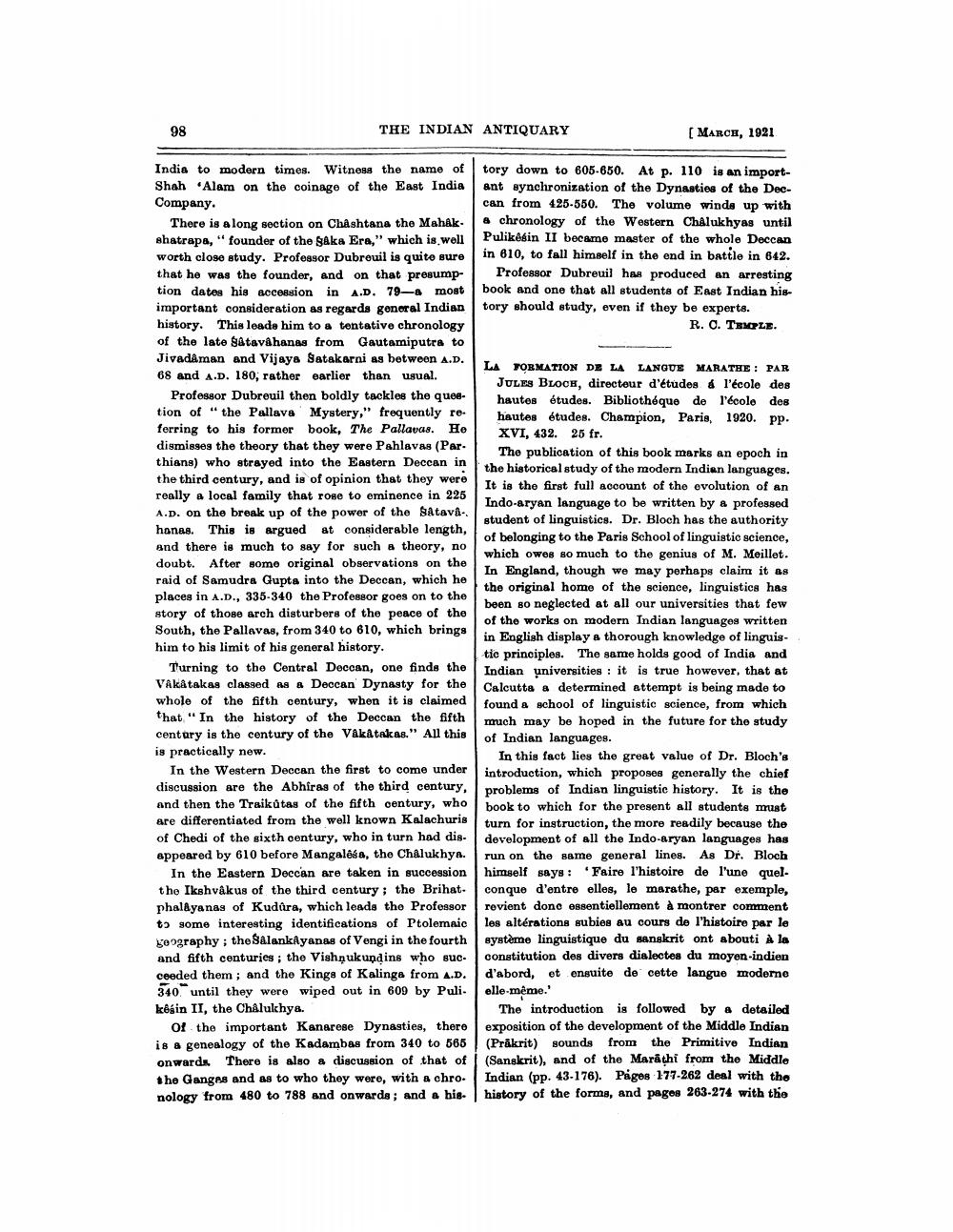________________
98
THE INDIAN ANTIQUARY
[MARCH, 1921
tory down to 605-650. At p. 110 is an important synchronization of the Dynasties of the Deecan from 425-550. The volume winds up with & chronology of the Western Chalukhyas until Pulikesin II became master of the whole Deccan in 810, to fall himself in the end in battle in 642.
Professor Dubreuil has produced an arresting book and one that all studenta of East Indian his tory should study, even if they be experts.
R. O. TEMPLE
India to modern times. Witness the name of Shah Alam on the coinage of the East India Company.
There is a long section on Chashtana the Mahak shatrapa," founder of the gAka Era," which is well worth close study. Professor Dubreuil is quite sure that he was the founder, and on that presumption dates his accession in A.D. 79-8 most important consideration as regards general Indian history. This leads him to a tentative chronology of the late Satavahanas from Gautamiputra to Jivadaman and Vijaya Satakarni as between A.D. 68 and A.D. 180, rather earlier than usual.
Professor Dubreuil then boldly tackles the queetion of the Pallava Mystery," frequently referring to his former book, The Pallavas. He dismisses the theory that they were Pahlavas (Par. thians) who strayed into the Eastern Deccan in the third century, and is of opinion that they were really a local family that rose to eminence in 225 A.D. on the break up of the power of the Satava.. hones. This is argued at considerable length, and there is much to say for such a theory, no doubt. After homo original observations on the raid of Samudra Gupta into the Deccan, which he places in A.D., 335-340 the Professor goes on to the story of those arch disturbers of the peace of the South, the Pallavas, from 340 to 610, which brings him to his limit of his general history.
Turning to the Central Deccan, one finds the VAKAtakas classed as a Deccan Dynasty for the whole of the fifth century, when it is claimed that "In the history of the Deccan the fifth century is the century of the Vikatakas." All this is practically new.
In the Western Deccan the first to come under discussion are the Abhiras of the third century, and then the Traikûtas of the fifth century, who are differentiated from the well known Kalachuris of Chedi of the sixth century, who in turn had dis. appeared by 610 before Mangalēéa, the Chalukhya.
In the Eastern Deccan are taken in succession the Ikshvâkus of the third century; the Brihat. phal yanas of Kudara, which leads the Professor to some interesting identifications of Ptolemaic goography : the AlankAyanas of Vengi in the fourth and fifth centuries; the Vishṇukundins who suc- ceeded them; and the Kings of Kalinga from A.D. 340 until they were wiped out in 609 by Puli. kegin II, the Chalukhya.
of the important Kanarese Dynasties, there is a genealogy of the Kadambas from 340 to 565 onwards. There is also a discussion of that of the Ganges and as to who they were, with a chro. nology from 480 to 788 and onwards; and a his-
LA FORMATION DE LA LANGUE MARATHE: PAR
JULES BLocs, directeur d'études & l'école des hautes études. Bibliothéque de l'école des hautes études. Champion, Paris, 1920. pp. XVI, 432.25 fr.
The publication of this book marks an epoch in the historical study of the modern Indian languages. It is the first full account of the evolution of an Indo-aryan language to be written by a professed student of linguistics. Dr. Bloch has the authority of belonging to the Paris School of linguistic science, which owes so much to the genius of M. Meillet. In England, though we may perhaps claim it as the original home of the science, linguistics has been so neglected at all our universities that few of the works on modern Indian languages written in English display a thorough knowledge of linguis. tio principles. The same holds good of India and Indian universities : it is true however, that at Calcutta a determined attempt is being made to found a school of linguistic science, from which much may be hoped in the future for the study of Indian languages.
In this fact lies the great value of Dr. Bloch's introduction, which proposes generally the chief problems of Indian linguistic history. It is the book to which for the present all students must turn for instruction, the more readily because the development of all the Indo-aryan languages has run on the same general lines. As Dr. Bloch himself says: 'Faire l'histoire de l'une quel conque d'entre elles, le marathe, par exemplo, revient donc essentiellement à montrer comment les altérations subies au cours de l'histoire par le système linguistique du sanskrit ont abouti A la constitution des divers dialectes du moyen indien d'abord, et ensuite de cette langue modemo elle-même.
The introduction is followed by a detailed exposition of the development of the Middle Indian (Prakrit) sounds from the Primitive Indian (Sanskrit), and of the Marathi from the Middle Indian (pp. 43-176). Påges 177-262 deal with the history of the forms, and pagos 263-274 with the




